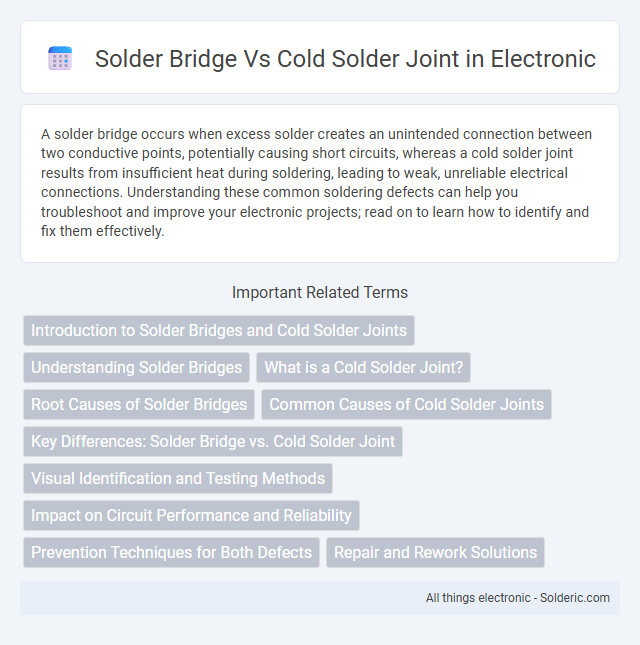A solder bridge occurs when excess solder creates an unintended connection between two conductive points, potentially causing short circuits, whereas a cold solder joint results from insufficient heat during soldering, leading to weak, unreliable electrical connections. Understanding these common soldering defects can help you troubleshoot and improve your electronic projects; read on to learn how to identify and fix them effectively.
Comparison Table
| Feature | Solder Bridge | Cold Solder Joint |
|---|---|---|
| Definition | Unintentional solder connection between adjacent pads or pins | Poorly formed solder joint with weak mechanical and electrical connection |
| Cause | Excessive solder or incorrect soldering technique | Insufficient heating or contaminated surfaces during soldering |
| Appearance | Shiny lump connecting two or more pads | Dull, grainy, or cracked solder with irregular surface |
| Electrical Impact | Unintended short circuit between components | Intermittent or high-resistance connection leading to failure |
| Mechanical Strength | Strong unintended connection | Weak and fragile joint |
| Detection Method | Visual inspection, continuity testing | Visual inspection, X-ray, thermal cycling tests |
| Solution | Remove excess solder, rework to separate pads | Reheat and apply fresh solder for reliable joint |
Introduction to Solder Bridges and Cold Solder Joints
Solder bridges occur when excess solder creates an unintended electrical connection between adjacent pads or leads, causing short circuits in electronic assemblies. Cold solder joints result from insufficient heat during soldering, leading to weak, unreliable connections with poor mechanical strength and high resistance. Both defects compromise circuit performance and require careful inspection during PCB assembly to ensure proper functionality.
Understanding Solder Bridges
A solder bridge occurs when excess solder creates an unintended electrical connection between two adjacent conductive pads, causing shorts that disrupt circuit functionality. Unlike cold solder joints, which result from insufficient heat and lead to weak, brittle connections, solder bridges stem from excessive solder flow during the soldering process. Detecting and preventing solder bridges involves precise temperature control and careful solder application to maintain circuit integrity and avoid signal interference.
What is a Cold Solder Joint?
A cold solder joint occurs when solder fails to melt properly, creating a weak and unreliable electrical connection prone to intermittent faults and high resistance. Unlike a solder bridge, which is an unintended connection between two conductors, a cold solder joint results from insufficient heating or movement during cooling, leading to a dull, grainy appearance. Inspect Your solder joints carefully to avoid cold solder joints that can cause circuit malfunctions and affect overall device performance.
Root Causes of Solder Bridges
Solder bridges occur primarily due to excessive solder paste application or poor pad spacing on a PCB, causing unintended connections between adjacent pads or leads. Inadequate solder mask definition and improper stencil design can also lead to solder bridges by allowing solder to spread uncontrollably during reflow. High reflow temperatures or improper flux usage exacerbate the risk by promoting solder migration and bridging between components.
Common Causes of Cold Solder Joints
Cold solder joints commonly result from insufficient heat during soldering, causing poor metal bonding and weak electrical connections. Contaminated surfaces, such as oxidized pads or components, prevent proper solder flow and adhesion. Your soldering technique, including inadequate solder amount or movement before cooling, also significantly contributes to cold solder joint formation.
Key Differences: Solder Bridge vs. Cold Solder Joint
A solder bridge occurs when excess solder creates an unintended electrical connection between adjacent pads or pins, causing potential short circuits. A cold solder joint results from insufficient heat during soldering, leading to weak mechanical bonds and poor electrical conductivity that can cause intermittent connections. Understanding these key differences helps you ensure reliable circuit performance by avoiding shorts from solder bridges and connection failures from cold solder joints.
Visual Identification and Testing Methods
A solder bridge appears as an unintended metallic connection between adjacent pads or traces, often visible as a shiny, smooth blob linking two points, whereas a cold solder joint looks dull, grainy, or cracked, indicating poor wetting or bonding. Visual inspection under magnification can distinguish a solder bridge by its continuous solder filament, while cold joints exhibit irregular surfaces and possible gaps. Testing methods include continuity tests with a multimeter to detect unwanted connections for solder bridges and resistance or signal integrity tests to identify intermittent or high-resistance connections caused by cold solder joints.
Impact on Circuit Performance and Reliability
A solder bridge creates unintended electrical connections that can cause short circuits, leading to circuit malfunction or failure. A cold solder joint results in poor electrical conductivity and intermittent connections, causing unreliable circuit performance and potential signal loss. Both defects compromise the integrity and longevity of electronic devices but require different diagnostic and corrective approaches to ensure reliable operation.
Prevention Techniques for Both Defects
Proper soldering temperature control and using the correct soldering iron tip size are essential to prevent cold solder joints by ensuring consistent heat application. Preventing solder bridges requires careful solder paste application, precise component placement, and adequate solder mask design to avoid unintended connections. Employing flux correctly and performing thorough visual inspections or X-ray analysis can effectively reduce the occurrence of both solder bridges and cold solder joints.
Repair and Rework Solutions
Solder bridges often require precise rework using desoldering tools or solder wick to remove excess solder without damaging surrounding components, ensuring clean electrical connections. Cold solder joints demand reheating and applying fresh solder to restore proper bonding and conductivity, preventing intermittent faults in your circuits. Effective repair and rework solutions rely on correct temperature control and inspection methods to maintain reliable PCB functionality.
Solder bridge vs cold solder joint Infographic

 solderic.com
solderic.com